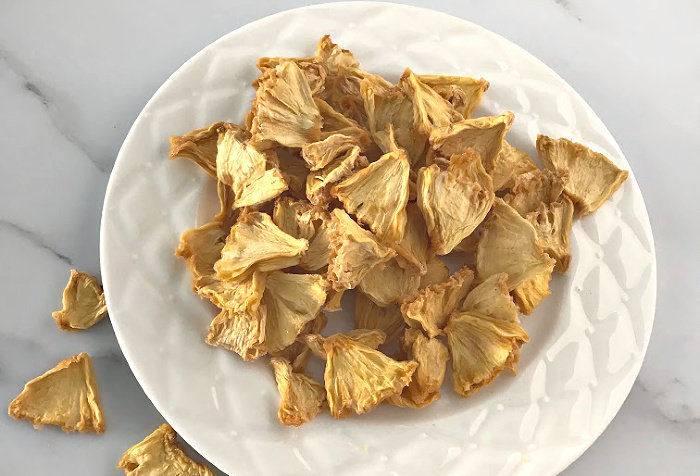
It’s all about dehydrating pineapple when it’s fresh and juicy. You can see why I’ve been showing you different foods to dehydrate. I would love it if everyone could get a dehydrator of some kind. You’ll love knowing how to dehydrate pineapple!
This is probably my favorite fruit to dehydrate. My grandkids love freeze-dried pineapple. Of course, I can’t freeze-dry my stuff, so I dehydrate it.
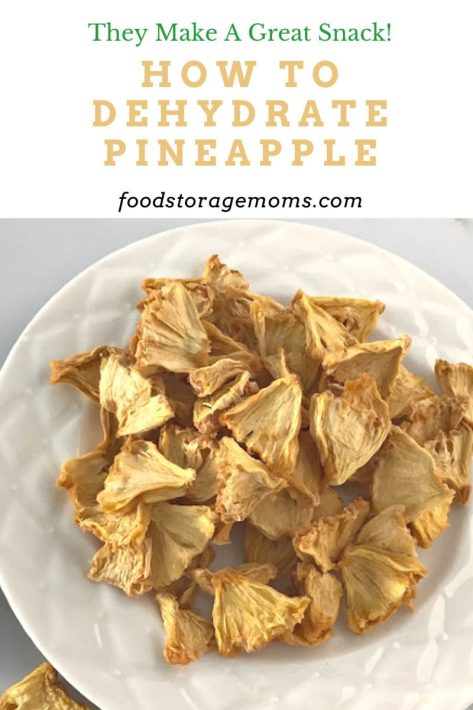
I had purchased some pineapple from Costco, and I could see that my husband and I couldn’t eat it as quickly as I had thought. So I put the dehydrator on the counter and started slicing the spears on my cutting board using a sharp knife so I could make my own homemade dehydrated pineapple. You want to have fairly thin slices so they’ll fully dehydrate in a reasonable time.
It’s so easy! Here’s the deal: If you have any fruit you know you won’t be able to eat the next day, you can usually dehydrate it. I do bananas all the time. Dehydrated fruits take up less freezer or shelf space when you put them in an airtight container.
Is Pineapple Good For Me?
- Alleviates arthritis pain
- Helps with digestion
- It may boost immunity and suppress inflammation
- It may help speed recovery after surgery
- Contains disease-fighting antioxidants
- Possibly reduce the chance of cancer
How Can I Use Pineapple?
- Hamburgers with a pineapple ring
- Pineapple Cream Cheese Dip
- Watergate Salad
- Baked ham with pineapple slices
- Pineapple Fruit Salad
- Delicious in smoothies as a sweet treat
- Great snacks for lunch boxes
How To Dehydrate Pineapple
You can cut them into thin slices and then into pineapple chunks as shown. I like fresh pineapple when I dehydrate it, but you can use canned pineapple if you’re getting close to an expiration date and want more long-term storage options. Drain the pineapple chunks to remove as much moisture as possible. I’d probably prepare a meal from the canned fruit, but it is an option.
Place the pineapple pieces on your dehydrator trays in single layers to reduce the drying time and so they don’t stick together. Leave a little space between the pieces for proper airflow for each batch.
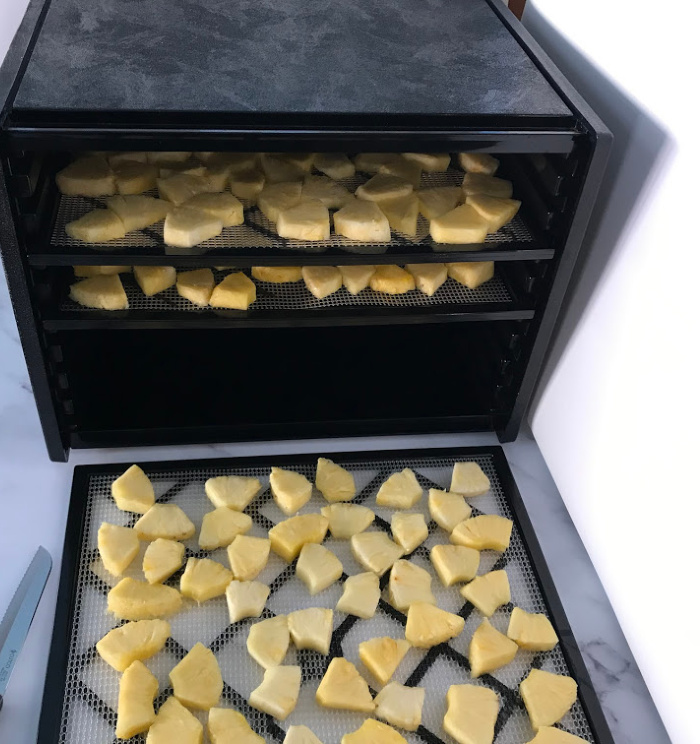
Here is the finished product. These dehydrated pineapple pieces are ready to take camping, hiking or just to snack on!
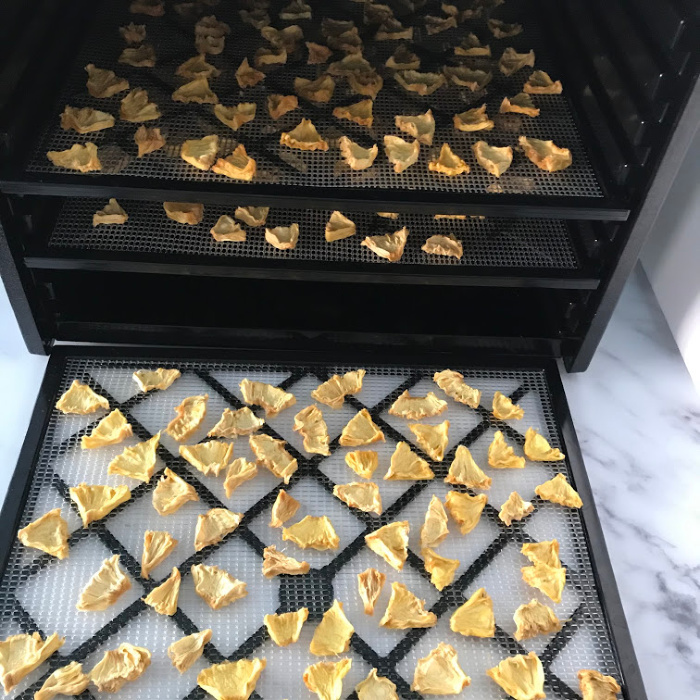
How Do I Store My Dehydrated Pineapple?
How To Condition Your Fruit or Vegetables
If you live where it is HUMID: “To condition the fruit, take the cooled, dried fruit and pack it loosely in plastic or glass jars. Seal the containers and let them stand for 7 to 10 days. The excess moisture in some pieces will be absorbed by the drier pieces. Shake the jars daily to separate the pieces and check the moisture condensation.” https://nchfp.uga.edu/how/dry/pack_store.html
When I lived in Southern Utah, it was a DRY DESERT; I set my fruit and vegetables on my countertop for 5-7 days. Ten days is even better to ensure everything is dry before using your FoodSaver unit.
I use quart mason jars and seal them with my FoodSaver, as shown below. The FoodSaver provides a vacuum seal that helps protect the dehydrated fruit. These are my favorite storage container options.
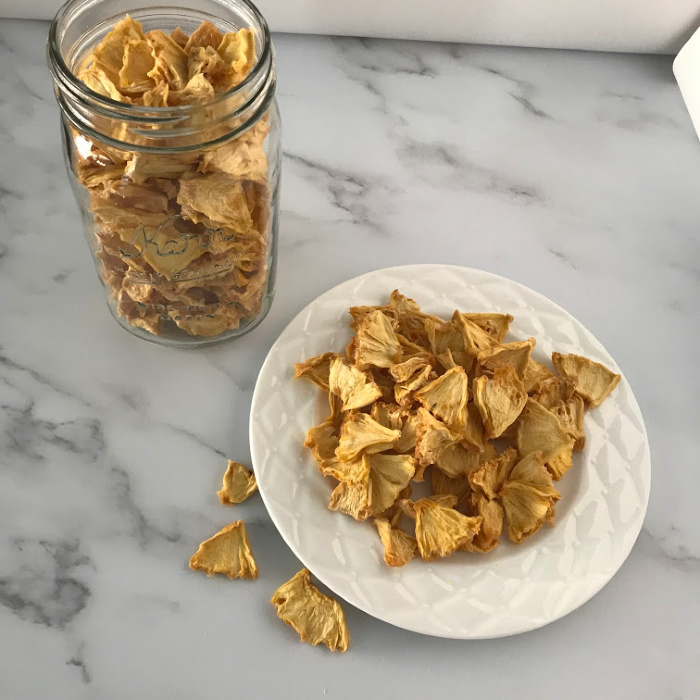
Shelf-Life Of Home-Dehydrated Pineapple?
As a Master Canner Preserver, I can safely say they will store well for one year if dehydrated properly. They still taste good as they retain most of their original flavor and sweetness, yet don’t lose their nutritional value. I like having shelf-stable items in my pantry so they’re accessible when it’s time to prepare a family meal.
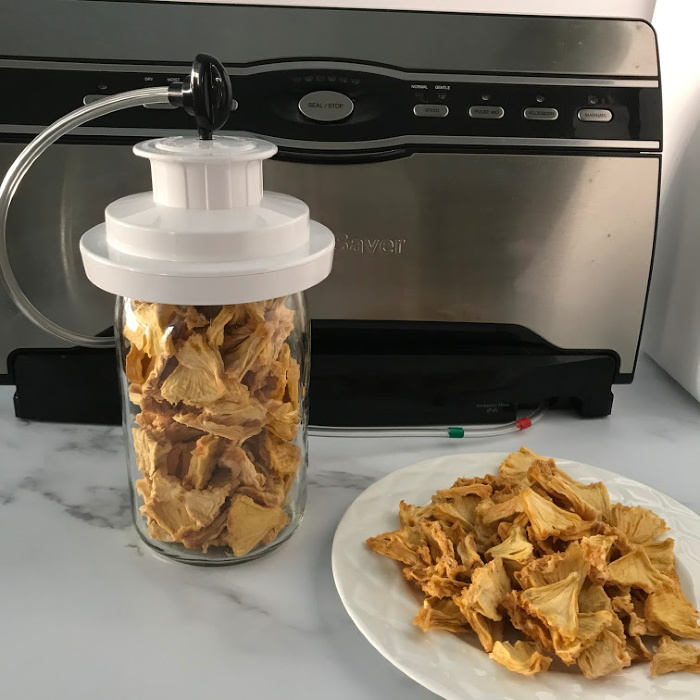
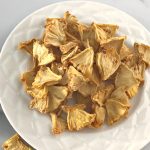
Dehydrating Pineapple
Ingredients
- 1-3 pineapples, clean, and sliced 1/2 inch thick
Instructions
-
Wash the outer rinds carefully and thoroughly. Cut the top off if using fresh pineapple.
-
You slice the spears into 1/4 to 1/2 inch pieces and place them on the dehydrator racks.
-
I set my Excalibur Dehydrator at (135°F) = (57°C) degrees.
-
Be sure and check your brand of dehydrator for the temperature that is required.
-
These took about 9 hours.
-
I like to dry mine so they are still a little pliable but not too crispy.
-
I place them in quart jars and use my FoodSaver to remove the air from the jars. These are a great healthy snack!
How To Condition Your Fruit or Vegetables
-
If you live where it is HUMID: “To condition the fruit, take the cooled, dried fruit and pack it loosely in plastic or glass jars. Seal the containers and let them stand for 7 to 10 days. The excess moisture in some pieces will be absorbed by the drier pieces. Shake the jars daily to separate the pieces and check the moisture condensation.” https://nchfp.uga.edu/how/dry/pack_store.html I used live in Southern Utah the DRY DESERT: I set my fruit and vegetables on my countertop for 5-7 days. Ten days is even better to ensure everything is dry before using your FoodSaver unit.
Can I use my oven to dehydrate pineapple and other fruits?
People have been using their oven to dehydrate fruits, vegetables, and meats for decades. You need to set the oven temperature at its lowest setting, place the sliced fruit on a baking sheet, and leave the oven door ajar using a wad of foil. You’ll need to check the dehydrating process often since each oven’s low-temperature setting is different.
Here are other Dehydrating Posts I Have Done:
- Dehydrating Apples
- Dehydrating Bananas
- Dehydrating Blackberries and Powder
- Dehydrating Blueberries and Powder
- Dehydrating Cilantro
- Dehydrating Cucumbers and Powder
- Dehydrating Ginger and Powder
- Dehydrating Green Onions and Powder
- Dehydrating Kale and Kale Powder
- Dehydrating Kiwi
- Dehydrating Lemons and Powder
- Dehydrating Marshmallows
- Dehydrating Peppermint Marshmallows and Powder
- Dehydrating Mushrooms and Mushroom Powder
- Dehydrating Onions and Powder
- Dehydrating Pears
- Dehydrating Pineapple
- Dehydrating Raspberries and Powder
- Dehydrating Spinach and Powder
- Dehydrating Strawberries
- Dehydrating Tomatoes and Powder
- Dehydrating Watermelon
Final Word
No preservatives or chemicals, just a healthy snack for our family! Have you tried to dehydrate pineapple? It’s one of my favorite ones! May God Bless this world, Linda
The post How to Dehydrate Pineapple appeared first on Food Storage Moms.
from Food Storage Moms
No comments:
Post a Comment